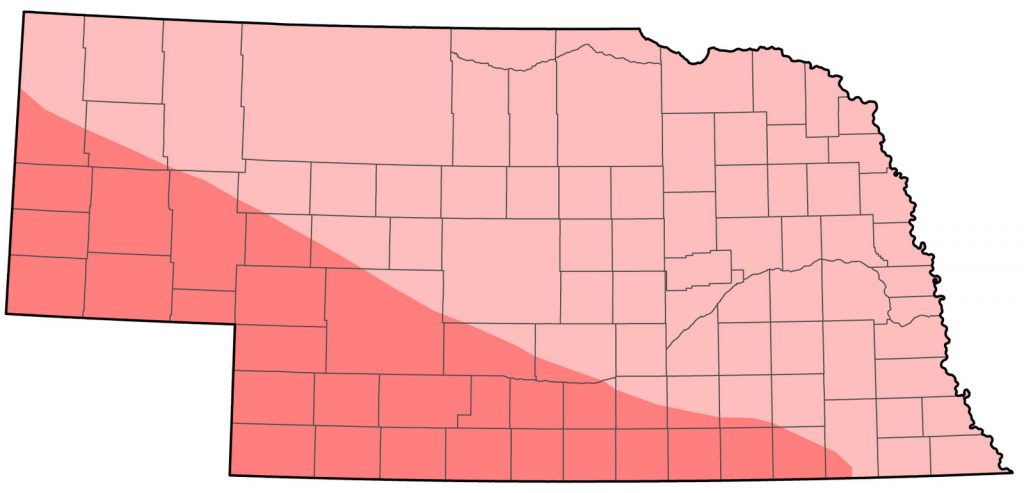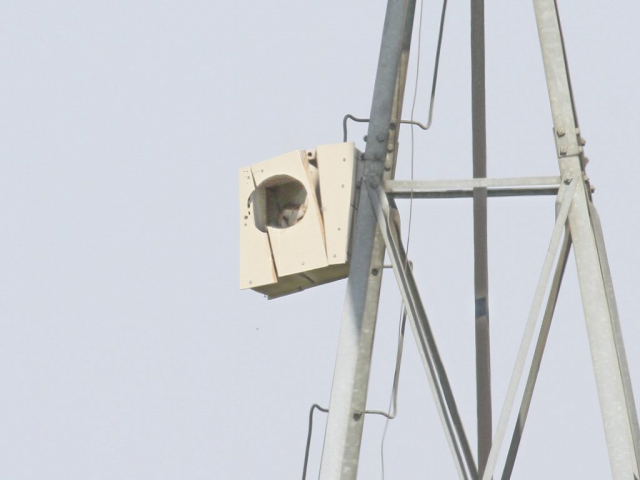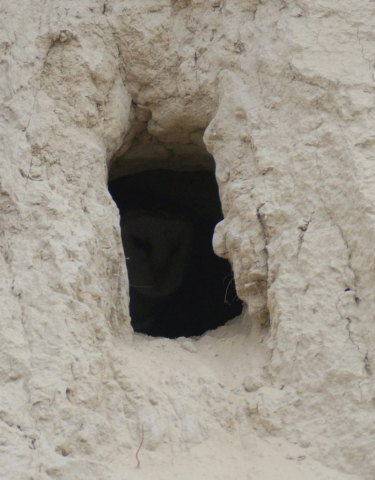Tyto FURCATA PRATINCOLA
Status: Increasing. Uncommon regular spring and fall migrant west and central, rare east. Uncommon regular breeder west and southwest, rare elsewhere. Rare casual winter visitor south and east.

Documentation: Specimen: UNSM 7719, 30 Apr 1903 Elm Creek, Buffalo Co.
Taxonomy: Nine subspecies are recognized by AviList (2025), only one, pratincola, occurring north of Mexico.
Recently, genetic (Uva et al 2018) and vocalization (Robb 2015) studies distinguished three major clades among the former 30 or so Barn Owl subspecies, each clade since accorded species rank: Western (T. alba), Eastern (T. javanica), and American (T. furcata) Barn Owls. This treatment was adopted by the American Ornithological Society (Chesser et al 2024).
Spring: Mar 10, 10, 11 <<<>>> summer
Earlier dates are 5 Mar 2005 Lincoln Co, and 8 Mar 2025 Curtis, Lincoln Co.
Arrival is in late Mar, although there are earlier reports which may be of wintering birds. Almost all Nebraska reports are in the period Apr-Oct although one had arrived at a cliff nesting site in Scotts Bluff Co 28 Feb.
Summer: Barn Owl occurs statewide in summer; highest densities occur in the southwest and westward in the North Platte River Valley, with fewest reports from the northeast. There had been no nesting records since 1900 from north and east of Holt, Boone, and Platte Cos (Ducey 1988) until 2005, but since then there have been at least five, with one site used for more than a single season. This change may be due to recent warmer winters allowing wintering and/or breeding further north and east. Recent surveys (Olson 2009) have found Barn Owls nesting in Missouri River banks with soft sand layers allowing excavation of nest holes in South Dakota from the Nebraska boundary as far north as the North Dakota border (Olson 2009, Drilling et al 2016).
Nesting data for the five-year period 1985-89 (Bennett 1986, 1987, 1988, 1989, 1990) indicate that this species reaches its peak abundance as a breeding bird in the southwest; a total of 221 nests were reported, including 78 in Lincoln Co, 48 in Frontier Co, and 14 in Hitchcock Co. Other studies (Wingfield 1982, 1983, 1984, 1985; Linderholm 1987) showed a similar spatial distribution. A total of eight birds were at Red Willow Reservoir SRA, Frontier Co 7 Jun 2006, and a nest under a bridge in Deuel Co had eight young 10 Jun 2006.
Elsewhere in the west, breeding has occurred regularly at Crescent Lake NWR, Garden Co where as many as 11 were counted 6 Jun 1995, five were roosting in a willow thicket there 8 Sep 1997, three nest boxes were occupied 5 May 2018, and four boxes 5 Jun-11 Jul 2021. This population may have been at least augmented by placement of as many as seven nest boxes on the refuge in the 1980s (Huber 1987) as part of a reintroduction program with a goal of placing 35 nest boxes (Lock 1980). In Keith Co, a notable report was of 12 birds in two family groups using holes about a mile apart in a canal embankment between Roscoe and Paxton 25 Jul-9 Aug 2014. A good tally of six were using holes in a rock embankment near Gering, Scotts Bluff Co 10-20 Jul 2022, and one was in a cut-bank hole in Sioux Co 17 Aug 2008.
A NGPC captive breeding and reintroduction program began in 1980 in Lancaster Co; young birds were successfully hacked that year at two rural Lancaster Co locations (Hancock et al 1981).
As indicated above, reports in the northeast are recent. At least three sites near Creighton, Knox Co have been occupied since 2005, one continuously, with grain bins favored for nesting. In 2015, a nest at Ponca SP, Dixon Co was discovered 9 Jun and had seven young 31 Jul and three nestlings and four fledged young nearby on 13 Aug; six of the seven chicks were fledged (Spilker and Gubanyi 2017). Pellets were collected from this nest site and analyzed for diet composition; a surprising finding was that 39% of the diet consisted of a small species, Western Harvest Mouse (Rheithrodontomys megalotis), that would require multiple captures for maintenance of body weight, whereas 32% consisted of two vole (Microtus) species, which are about four times as heavy (Spilker and Gubanyi 2017). A nest at Ponca SP in 2018 had three nestlings 18 Aug, two on 2 Sep; a nest there in 2019 had six young 27-28 Jul with two almost full-grown fledglings still present 21 Aug. A nest with eggs was in a grain bin in Boone Co 22 Jul 2022. An adult was at the latter site 12 Jun 2020. A brood of seven chicks about two weeks old in a grain bin in Platte Co was removed prior to the bin being emptied 22 May 2012. A likely family group of four was at a Dodge Co farm 25 Aug 2013. The only other reports in the extreme northeast are of a road-killed bird 31 Mar 2005 Pierce Co, and singles in a farm barn in Stanton Co 10 Apr 2018, near Crofton, Cedar Co 26 Apr 2021, at Niobrara SP, Knox Co 28 Apr 2023, 29 Apr 1990 Cedar Co, and 15 May 2025 and 18 May 1995 Wayne Co.
In north-central Nebraska, east of the Panhandle, one near Berwyn, Custer Co had seven young, at least four of which had fledged by 19 Aug 2010. A brood of seven in a grain bin was photographed 15-20 miles east of Chambers, Holt Co during Aug 1999 (Loren “Bub” Blake, personal communication). It was considered a rare summer resident at NNF Bessey, Thomas Co by Bray (1994). Three fully-fledged young were observed in 1985, where nesting had occurred several years prior, at the U.S. Fish and Wildlife Service fire tower at Valentine NWR, Cherry Co (Wingfield 1985). There are no nesting reports since, although there are two fire towers still present as of 2017 (Juancarlos Giese, personal communication). There are three other reports in Cherry Co: one in a cut bank east of Valentine 8 Sep 1984, one south of NNF McKelvie 12 Aug 2013, and one about 15 miles southwest of Valentine 30 May 2020. Further south, one was at Calamus Reservoir SRA, Loup Co 24 May 1997, and one was near Broken Bow, Custer Co 19 Apr 2012.
Records of breeding in the southeast are few. In the eastern Rainwater Basin, Jorgensen (2012) considered it a “rare spring and fall migrant and breeder”. Breeding occurred at Ulysses, Butler Co 2005-2008 in an old school building (Mollhoff 2006, Silcock 2006, 2008). In Lancaster Co in 2022, a nest cavity in a Salt Creek bank contained two young 17 Aug, but only one on 20 Aug and none on 29 Aug, when a Great Horned Owl was seen leaving the nest cavity (Elizabeth Cisne, personal communication) although the same cavity was occupied 29 Oct by two Barn Owls. In 2025, a drainage pipe at Marsh Wren Community Wetlands, only 3/8 mi from the 2024 nest site thus likely the same breeders, was occupied in May by an adult, and by 29 Jul, two near-grown nestlings were present.
An interesting observation was use by this species of old grain elevators at Merriman, Cherry Co 10 Aug 2024 and Hay Springs 17 Aug 2024.
- Breeding Phenology:
Eggs: 4 Apr- 6 Aug (Mollhoff 2022)
Nestlings: 19 Apr (Linderholm 1987)-15 Sep
Three broods were brought to Fontenelle Forest Raptor Recovery in 2014 at remarkably late dates: 15 Oct and 31 Oct from Keith Co, and 6 Nov from Buffalo Co. A study in southwest Nebraska found that 86% of eggs in 47 nests hatched late May-early Jun (Linderholm 1987). An injured bird captured 4 Sep 2021 in Saline Co had a brood patch and was presumed to be a local breeder (Joseph Gubanyi, personal communication).
Fall: summer <<<>>> Oct 4, 4, 4
Later dates are 9 Oct 2020 Dundy Co, 9 Oct 2010 Custer Co, 15 Oct 2004 Dawes Co, 15 Oct 2011 Nuckolls Co, 26 Oct 2009 Lincoln Co, 5 Nov 2021 Antelope Co, and 18 Nov 2014 Hall Co. Dates Dec-Feb are cited in Winter (below).
Most of the Nebraska population departs in Oct, although occasional late broods (see Breeding Phenology) would account for lingering birds.
Winter: Some authors consider this species resident in Nebraska (Tout 1947, Marti et al 2020), although there are no documented reports of overwintering individuals. Since Nebraska is near the north edge of the species’ breeding range, most individuals probably depart prior to winter. Bent (1938) indicated that banding data show often-extensive movements which suggest migration, although Marti et al (2020) considered that generally the species is sedentary except for “some regions of the northern US.” A Barn Owl banded (band # 987-63280) at Fort Calhoun, Washington Co, Nebraska 22 Sep 1982 was recovered near Monroe, Wisconsin 11 Jan 1983. Two Barn Owls in Dixon Co as late as 14-19 Dec 2022 and one there 19 Mar 2023 were in a grassland area where nesting had been reported in several years since 2015, suggesting possible residency.
There are only about 33 records Dec-Feb, only these 11 since 1976: 6 Dec 2011 Rowe Sanctuary, Buffalo Co, 14-19 Dec 2023 (2) Ponca SP, Dixon Co, 15 Dec 1984 Dakota Co, 19 Dec 2003 Johnson Lake SRA, Dawson and Gosper Cos, 23 Dec 2024 Sutherland Reservoir, Lincoln Co, 28 Dec 2006 photographed Lake McConaughy, Keith Co, 29 Dec 1977 Cedar Co, Jan 2006 call heard along the Niobrara River, Cherry Co and compared to recordings (James Ducey, personal communication), 24 Jan 2025 Nuckolls Co, 1 Feb 2003 found dead in good condition in a barn Wayne Co, 14 Feb 2018 Furnas Co, and 20 Feb 1981 Colfax Co, two found dead (Peters and Schmidt 1981).
Images
Abbreviations:
NNF: Nebraska National Forest
NWR: National Wildlife Refuge
SP: State Park
SRA: State Recreation Area
UNSM: University of Nebraska State Museum
Literature Cited:
AviList Core Team, 2025. AviList: The Global Avian Checklist, v2025. https://doi.org/10.2173/avilist.v2025.
Bennett, E.V. 1986. 1985 Nebraska nesting survey. NBR 54: 31-35.
Bennett, E.V. 1987. 1986 Nebraska nesting survey. NBR 55: 31-35.
Bennett, E.V. 1988. 1987 Nebraska nesting survey. NBR 56: 35:40.
Bennett, E.V. 1989. 1988 Nebraska nesting report. NBR 57: 34-41.
Bennett, E.V. 1990. 1989 Nebraska nesting report. NBR 58: 38-45.
Bent, A.C. 1938. Life histories of North American birds of prey. Part Two. Bulletin of the United States National Museum 170. Dover Publications Reprint 1961, New York, New York, USA.
Bray, T.E. 1994. Habitat utilization by birds in a man-made forest in the Nebraska Sandhills. Master’s thesis. University of Nebraska-Omaha, Omaha, Nebraska, USA.
Chesser, R.T., S.M. Billerman, K.J. Burns, C. Cicero, J.L. Dunn, B.E. Hernandez-Banos, R.A. Jimenez, O. Johnson, A.W. Kratter, N.A. Mason, P.C. Rasmussen, and J. V. Remsen, Jr. 2024. Sixty-fifth Supplement to the American Ornithologists’ Union Check-list of North American Birds. Ornithology 141. https://doi.org/10.1093/ornithology/ukae019.
Clements, J. F., T. S. Schulenberg, M. J. Iliff, D. Roberson, T. A. Fredericks, B. L. Sullivan, and C. L. Wood. 2016. The eBird/Clements checklist of birds of the world: v2016, accessed 30 January 2018.
Drilling, Nancy E., Robert A. Sparks, Brittany J. Woiderski, and Jason P. Beason. 2016. South Dakota Breeding Bird Atlas II: Final Report. Tech. Rep. M-SDBBA2-07. Bird Conservancy of the Rockies, Brighton, Colorado, USA.
Ducey, J.E. 1988. Nebraska birds, breeding status and distribution. Simmons-Boardman Books, Omaha, Nebraska, USA.
Hancock, B., J.E. Ducey, and R. Lock. 1981. Captive breeding of Barn Owls in Nebraska- initial efforts. NBR 49: 31-33.
Huber, R.R. 1987. Crescent Lake nesting records. NBR 55: 75.
Jorgensen, J.G. 2012. Birds of the Rainwater Basin, Nebraska. Nebraska Game and Parks Commission, Lincoln, Nebraska, USA.
Linderholm, B. 1987. Southwest Nebraska Barn Owl project report. Report submitted to the Nebraska Game and Parks Commission, Lincoln, Nebraska, USA.
Lock, R.A. 1980. Barn Owl management plan. Nebraska Game and Parks Commission, Lincoln, Nebraska, USA.
Marti, C.D., A.F. Poole, L.R. Bevier, M.D. Bruce, D.A. Christie, G.M. Kirwan, and J.S. Marks. 2020. Barn Owl (Tyto alba), version 1.0. In Birds of the World (S. M. Billerman, Editor). Cornell Lab of Ornithology, Ithaca, NY, USA. https://doi.org/10.2173/bow.brnowl.01.
Mollhoff, W.J. 2006. The 2006 Nebraska nest report. NBR 74: 142-147.
Mollhoff, W.J. 2022. Nest records of Nebraska birds. Nebraska Ornithologists’ Union Occasional Paper Number 9.
Olson, R.D. 2009. Barn Owl distribution on Lake Oahe. South Dakota Bird Notes 61: 5-7.
Peters, K.L., and R.H. Schmidt. 1981. Barn Owls. NBR 49: 25.
Robb, M. 2015. Undiscovered Owls: A Sound Approach Guide. The Sound Approach, Poole, UK.
Silcock, W.R. 2006. Summer Field Report, June-July 2006. NBR 74: 78-95.
Silcock, W.R. 2008. Summer Field Report, June-July 2008. NBR 76: 94-111.
Spilker, A., and J. Gubanyi. 2017. Diet and habitat analysis of Barn Owls (Tyto alba) nesting at Ponca State Park. NBR 85: 121-127.
Tout, W. 1947. Lincoln County birds. Published by the author, North Platte, Nebraska, USA.
Uva, V., M. Päckert, A. Cibois, L. Fumagalli, and A. Roulin. 2018. Comprehensive molecular phylogeny of barn owls and relatives (Family: Tytonidae), and their six major Pleistocene radiations. Molecular Phylogenetic Evolution 125: 127-137. doi: 10.1016/j.ympev.2018.03.013.
Wingfield, G. 1982. Barn Owl investigations – 1982. Nebraska Game and Parks Commission report, Lincoln, Nebraska, USA.
Wingfield, G. 1983. Barn Owl investigations – 1983. Nebraska Game and Parks Commission report, Lincoln, Nebraska, USA.
Wingfield, G. 1984. Barn owl nesting investigations in western and central Nebraska – 1984. Nebraska Game and Parks Commission report, Lincoln, Nebraska, USA.
Wingfield, G. 1985. Barn owl nesting investigations in western and central Nebraska – 1985. Nebraska Game and Parks Commission report, Lincoln, Nebraska, USA.
Recommended Citation
Silcock, W.R., and J.G. Jorgensen. 2025. Barn Owl (Tyto alba). In Birds of Nebraska — Online. www.BirdsofNebraska.org
Birds of Nebraska – Online
Updated 24 Aug 2025


